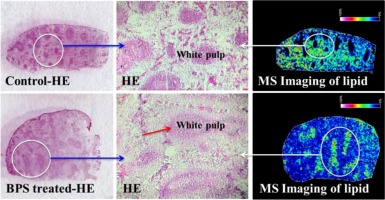当前位置:
X-MOL 学术
›
Environ. Int.
›
论文详情
Our official English website, www.x-mol.net, welcomes your
feedback! (Note: you will need to create a separate account there.)
Evaluation of the splenic injury following exposure of mice to bisphenol S: A mass spectrometry-based lipidomics and imaging analysis.
Environment International ( IF 10.3 ) Pub Date : 2019-12-12 , DOI: 10.1016/j.envint.2019.105378 Chao Zhao 1 , Ting Yong 2 , Yinbin Zhang 3 , Yaofeng Jin 3 , Yu Xiao 4 , Hailin Wang 5 , Bin Zhao 5 , Zongwei Cai 2
Environment International ( IF 10.3 ) Pub Date : 2019-12-12 , DOI: 10.1016/j.envint.2019.105378 Chao Zhao 1 , Ting Yong 2 , Yinbin Zhang 3 , Yaofeng Jin 3 , Yu Xiao 4 , Hailin Wang 5 , Bin Zhao 5 , Zongwei Cai 2
Affiliation

|
BACKGROUND
The widespread use of bisphenol A (BPA) substitutes has aroused great attention towards their toxicological evaluation in vivo and in vitro. Considering the intimate correlation between BPA and metabolic diseases, we explored whether bisphenol S (BPS), a major substitute to BPA, could cause the splenic toxicity by disturbing the lipid metabolism in mouse model.
METHODS
We investigated the splenic injury by combing the mass spectrometry (MS)-based lipidomics and imaging analysis, as well as molecular biological methods. Mice were divided into three groups (control-olive oil, 10 and 100 μg-BPS/kg body weight/day group) and treated by BPS in 56 days.
RESULTS
Two of BPS-treated concentrations induced the splenic morphological alterations and inflammation, including the decreased numbers and cellularity in the periarteriolar lymphoid sheath (T cell zone) and paucicellular primary lymphoid follicles (B cell zone) in splenic white pulp. Lipidome profiling of spleen after BPS treatment was also changed with up-regulated sphingosine [So], neutral glycosphingolipids [CerG], cholesteryl ester [ChE], diacylglycerols [DAG], lysophosphatidylcholine [LPC], lysophosphatidylethanolamine [LPE], phosphatidylglycerols [PG], phosphatidylinositols [PI] and phosphatidylserine [PS] as well as down-regulated ceramide [Cer], phosphatidylethanolamines [PE] and sphingomyelin [SM] compared to the control group. More importantly, significant different lipids in abundance and spatial distribution also implicated that white pulp were more sensitive to BPS treatment than other splenic sub-structures. Signaling lipids such as So (d18:0), Cer (d18:1/24:0), Cer (d18:1/22:0), SM (d18:1/22:1) and SM (d18:1/24:2) associated with inflammation were remarkable changed and co-localized in the splenic white pulp.
CONCLUSIONS
Our finding indicated that BPS exposure promoted the splenomegaly, pro-inflammatory activation and morphological alterations, as well as induced the lipidome perturbation in the immune cells of white pulp, which might be expected to contribute a new perspective of bisphenol-induced organ injury.
中文翻译:

小鼠双酚S暴露后的脾损伤评估:基于质谱的脂质组学和成像分析。
背景技术双酚A(BPA)替代物的广泛使用引起了对其体内和体外毒理学评价的极大关注。考虑到BPA与代谢疾病之间的密切关系,我们探讨了BPA的主要替代品双酚S(BPS)是否会通过干扰小鼠模型中的脂质代谢而引起脾毒性。方法我们通过结合基于质谱(MS)的脂质组学和影像学分析以及分子生物学方法研究了脾损伤。将小鼠分为三组(对照橄榄油,10和100μg-BPS/ kg体重/天组),并在56天内用BPS治疗。结果BPS处理的两个浓度均引起脾脏形态学改变和炎症,包括脾白髓中小动脉周围淋巴样鞘(T细胞区)和少泡初级淋巴滤泡(B细胞区)的数量和细胞减少。BPS处理后的脾脏血脂谱分布也随着鞘氨醇[So],中性糖鞘脂[CerG],胆固醇酯[ChE],二酰基甘油[DAG],溶血磷脂酰胆碱[LPC],溶血磷脂酰乙醇胺[LPE]的上调而改变与对照组相比,磷脂酰肌醇[PI]和磷脂酰丝氨酸[PS]以及下调的神经酰胺[Cer],磷脂酰乙醇胺[PE]和鞘磷脂[SM]。更重要的是,大量不同的脂质在丰度和空间分布上也暗示白浆比其他脾脏亚结构对BPS处理更敏感。信号脂质,例如So(d18:0),Cer(d18:1/24:0),Cer(d18:1/22:0),SM(d18:1/22:1)和SM(d18:1 / 24:2)与炎症相关的病变明显改变并共同定位在脾脏的白色牙髓中。结论我们的发现表明BPS暴露促进了脾肿大,促炎性激活和形态学改变,并在白浆免疫细胞中引起脂质组扰动,这有望为双酚诱导的器官损伤提供新的视角。
更新日期:2019-12-13
中文翻译:

小鼠双酚S暴露后的脾损伤评估:基于质谱的脂质组学和成像分析。
背景技术双酚A(BPA)替代物的广泛使用引起了对其体内和体外毒理学评价的极大关注。考虑到BPA与代谢疾病之间的密切关系,我们探讨了BPA的主要替代品双酚S(BPS)是否会通过干扰小鼠模型中的脂质代谢而引起脾毒性。方法我们通过结合基于质谱(MS)的脂质组学和影像学分析以及分子生物学方法研究了脾损伤。将小鼠分为三组(对照橄榄油,10和100μg-BPS/ kg体重/天组),并在56天内用BPS治疗。结果BPS处理的两个浓度均引起脾脏形态学改变和炎症,包括脾白髓中小动脉周围淋巴样鞘(T细胞区)和少泡初级淋巴滤泡(B细胞区)的数量和细胞减少。BPS处理后的脾脏血脂谱分布也随着鞘氨醇[So],中性糖鞘脂[CerG],胆固醇酯[ChE],二酰基甘油[DAG],溶血磷脂酰胆碱[LPC],溶血磷脂酰乙醇胺[LPE]的上调而改变与对照组相比,磷脂酰肌醇[PI]和磷脂酰丝氨酸[PS]以及下调的神经酰胺[Cer],磷脂酰乙醇胺[PE]和鞘磷脂[SM]。更重要的是,大量不同的脂质在丰度和空间分布上也暗示白浆比其他脾脏亚结构对BPS处理更敏感。信号脂质,例如So(d18:0),Cer(d18:1/24:0),Cer(d18:1/22:0),SM(d18:1/22:1)和SM(d18:1 / 24:2)与炎症相关的病变明显改变并共同定位在脾脏的白色牙髓中。结论我们的发现表明BPS暴露促进了脾肿大,促炎性激活和形态学改变,并在白浆免疫细胞中引起脂质组扰动,这有望为双酚诱导的器官损伤提供新的视角。











































 京公网安备 11010802027423号
京公网安备 11010802027423号